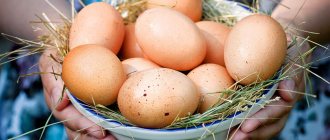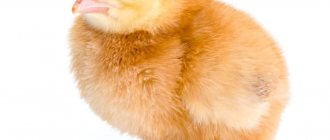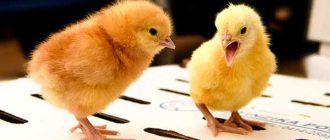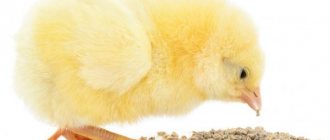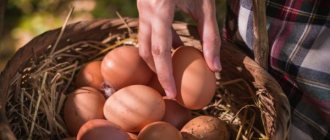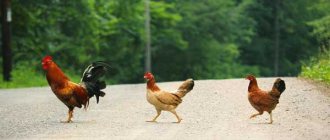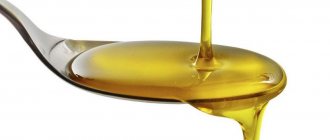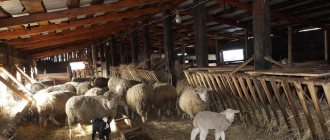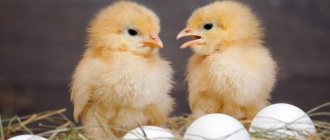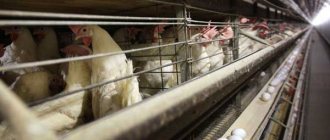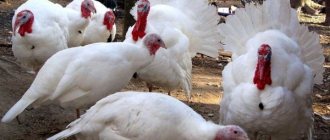What you need to know about raising chickens at home
Breeding young animals is one of the most important stages of running a successful poultry farm. If the chicks are hatched under a hen, no additional heating is required, since the chicken itself will provide the necessary temperature conditions and protection.
If a poultry farm plans to raise chickens from an incubator, a heated and fenced place must be prepared in advance for them.
Care
For young chickens, correct temperature conditions are extremely important. If it is kept within normal limits, the chicks are mobile, eat well and develop normally. If the temperature is too low, they begin to crowd and press closer to the heat source, quickly weaken and eat poorly. If the temperature is too high, the chicks will move away from the heat source, drink frequently, eat poorly, and spend a lot of time lying around.
A simple way to maintain temperature is to use a regular flask or heating pad, which is wrapped in thick cloth. The water must be changed periodically.
Lighting also plays an important role. In the first ten days of life, chicks should be exposed to light around the clock. In the future, the duration of daylight hours is gradually reduced and increased to 9-10 hours.
Content
In some farms, hatchery chickens are kept in special boxes that are covered with cloth and not heated. This is a gross mistake, since the chicks do not have enough warmth and air, and they very often die or are delayed in development.
Figure 1. Drawing and photo of a brooder
It is better to use special boxes or boxes, and install light bulbs or reflectors for heating (Figure 1). To prevent the chickens from running away from the heat source in the first few days, it needs to be covered with a cardboard screen. In the first five days, the temperature in the poultry house should be kept at 30 degrees. Subsequently, it is reduced: on the 10th day to 26 degrees, and then three degrees weekly until the temperature reaches 16-18 degrees.
Walking in the fresh air has a good effect on raising healthy and viable young animals. They can be carried out in warm, calm weather, since the sun's rays saturate the body with vitamin D. However, in damp and rainy weather, chickens can be walked only from two months of age.
Tips for Beginners
There are several practical tips that will help novice poultry farmers raise young birds correctly. First of all, it should be taken into account that it is better to raise chickens under a brood hen, since only she can provide the optimal temperature regime for the chicks.
In addition, it is important to consider a balanced diet. Some farms practice feeding exclusively with compound feed. However, this only makes sense if the birds are raised in large quantities for sale. For home breeding, it is better to prepare food yourself, using fine-grained cereals, dairy products, fresh herbs and vegetables.
Features of care
The chicks are born completely dependent. Therefore, nature took care of them and preserved a tiny supply of useful components in the gall sac. This supply is enough for several hours to provide the chicken with its vital needs.
From the first day of life, you can make your first acquaintance with the feeder . Over time, the chicks get used to it and can peck the food themselves.
What can you give?
Feed for broiler chickens from one month:
- Corn.
- Dairy products.
- Compound feed.
- Juicy greens.
- Vitamin complex.
Compliance with the rules
To provide babies with the necessary nutrition, it is recommended to follow these rules:
Feeders cannot be filled entirely , but only a third. Otherwise, the food will be raked and trampled.
- A drinking bowl with fresh water is placed in the poultry house , which needs to be changed regularly. The optimal temperature is 30 degrees. Access to the shelf must be free.
- Watch your birds carefully, they should all eat well. If some individuals do not go to the feeder, they need to be removed . Quarantined chickens are pipetted with milk and egg yolk.
- Feeders should be disinfected as often as possible . This can be done with a 5% formaldehyde solution, as well as hot soapy water.
- Fermentation or rotting of the feed is unacceptable; feeders must be regularly emptied of food debris .
- To prevent chickens from getting sick, they resort to preventive measures. Three times a week, children are given a concentrated solution of potassium permanganate . You can’t store it; they make a new one every time.
Hatching in an incubator
Incubation of chicken eggs is a very responsible task, because the efficiency of hatching the young will depend on the temperature and humidity. First of all, you need to select the eggs correctly. For this purpose, only high-quality specimens of characteristic shape and color are selected. In addition, they must be fresh (no more than 7 days), without growths or stains on the shell or any foreign unpleasant odor.
Before laying, the incubator chamber must be thoroughly washed and disinfected. At this time, the eggs are transferred to a room at room temperature for uniform heating, and the blunt or sharp end is marked with a marker to control the coup in the future.
It is very important to control temperature and humidity levels throughout the incubation period. With severe deviations, the embryos may die.
How do chicks hatch in an incubator?
Each stage has its own indicators (Table 1). In the first week, the temperature is maintained at 37.8 degrees with a humidity of 55%. The revolution is carried out 4 times a day at regular intervals, while trying not to ventilate the chamber too much. If it is possible to carry out a revolution without opening the lid, it is better to take advantage of this opportunity, since during this period ventilation is not only not needed by the embryos, but can also destroy them.
In the second week, the temperature is kept at the same level, and the humidity is gradually reduced to 45%. Turning over is carried out as before, but additional ventilation will be required - 5 minutes twice a day.
Table 1. Temperature and humidity at the main stages of incubation
Over the next four days, they continue to maintain the temperature, while increasing the humidity to 50%. Turning is required up to 6 times a day, the duration of ventilation is increased to 20 minutes. If you did everything correctly, by the end of the 18th day you will be able to hear a faint squeak from under the shell.
Starting from the 19th day, the turning of eggs is completely stopped, since by this time the chickens have time to get stronger. It is also necessary to reduce the temperature (to approximately 37.3 degrees), increasing the humidity to 65%. Ventilation is also carried out less frequently - only 5 minutes twice a day. From about 21 days, the eggs will begin to hatch into chicks and can be gradually transferred to the brooder after drying.
What to feed chickens
To ensure that the young do not have health problems or developmental delays, the correct diet must be followed immediately after hatching. In the future, the variety of food is gradually expanded, accustoming individuals to adult food.
It is important not only to choose the right products, but also to follow a specific feeding schedule. At first, food is given out every two hours, gradually increasing the interval between meals. At one month of age, the number of feedings should reach three times a day.
First of all, the diet depends on the age of the chicks, so we will consider in more detail what food to give at different periods of development of the young.
DIY food
Properly selected and prepared feed is the key to successful rearing of young animals. In order for the chicks to fully develop, you need to use only fresh and natural products, and it is better to give them out at the same time.
The following products are considered the best food for chicks:
- Cottage cheese mixed with fine corn grits in equal proportions;
- Ground oatmeal, wheat or barley;
- Low-fat kefir or yogurt serve as a valuable source of protein and calcium, so they are included in the diet within a few days after the chicks hatch;
- Greens (young nettle, plantain, dandelions, clover or green onions) in crushed form serve as a valuable source of vitamins and beneficial microelements;
- From the 10th day of life, boiled and fresh chopped vegetables are introduced into the diet;
- Mineral supplements and small pebbles are also an important part of feeding. They not only stimulate the process of food digestion, but also serve as an important source of microelements.
There should be separate feeders for dry and wet food, and when preparing wet mash it is important to strictly follow the proportions. You need to prepare only enough food to eat at one time. If the mash remains in the feeder, the chicks may contaminate it, or the product itself will turn sour and cause poisoning.
Poultry farms often practice feeding special feed for chickens. It is not at all necessary to buy it, since you can prepare a similar product yourself (Figure 2).
To prepare, you need to mix the following components (as a percentage of the total mass):
- Corn (50%);
- Wheat (16%);
- Cake (14%);
- Low-fat kefir (12%);
- Barley (8%).
Figure 2. Main components of compound feed
All grains are thoroughly crushed and mixed with kefir. This feed is used for the smallest chicks that have recently hatched. For older individuals, the list of components is expanded, supplementing it with fish meal, feed yeast, unrefined sunflower oil and fresh chopped herbs.
Feeding after hatching
The chicks retain small amounts of useful elements in their yolk sac. After hatching, they last for a while, so don't feed them right away. This is done 12-16 hours after birth. Chicks from the incubator are placed in a cardboard box, and
Chickens are fed at home separately from their mother. First, set up flat feeders. The feeding reflex appears immediately after eating the first food. If not all chicks are suitable for food, they are isolated and fed with a pipette. To do this, boiled yolk is mixed with water. They return the individuals to the others when they become stronger.
After hatching, corn grits are suitable as food. Some poultry farmers provide crushed egg yolk. Now there are different opinions about this product because it is too greasy. Pathogenic flora can develop in the intestines of babies when they consume it. If rough food is given after the yolk, indigestion occurs.
What to feed day-old chicks at home
Nutrition in the chicks on the first day plays an extremely important role. At this time, it is important to include foods in your diet that will help start the digestive tract. But don’t forget about nutritional value: all food must be fresh and balanced in vitamins and beneficial microelements.
There are certain differences between feeding chickens immediately after hatching and one day after that, so let’s take a closer look at what foods should be included in the diet and how to prepare them correctly.
After hatching
The first distribution of products is carried out immediately after the chicks hatch and dry out. This point plays a very important role, since physiologically chicks need to swallow something immediately after birth to start the digestive tract.
Note: In the first 10-12 hours, the young animals feed on the so-called gall sac, which remains with them from the time they were in the egg. But to prevent nutritional deficiencies, it is better to immediately put food into the brooder.
Figure 3. Diet of newborn chicks
The best option is considered to be fine corn grits, which can simply be scattered on thick cardboard inside the box (Figure 3). It is also necessary to provide the young animals with water: liquid at room temperature is poured into a special small drinking bowl. If desired, you can add a 3% glucose solution or a little vitamin C to it.
On the first day
Gradually the diet is made more varied. You can start introducing new products on the second or third day. During this period, corn grits can begin to be mixed with other grains: semolina, millet or ground oatmeal. The grain must be dry, as steamed grain can cause blockage of the nasal passages (Figure 4).
In the past, it was believed that it was best to feed chickens a boiled egg, but in fact this opinion is erroneous, since this product does not put the necessary stress on the stomach and does not contribute to the development of the digestive tract.
Figure 4. Example of a diet for day-old chicks
Dairy products – cottage cheese, kefir and yogurt – are considered an important component of the diet. Their use allows you to populate the intestines with beneficial microflora and improve the digestion process. In addition, it is a source of calcium and proteins necessary for bone formation. You can also gradually add fresh chopped herbs: young nettles, clover or green onions.
Chickens: feeding and maintenance in the first 3 weeks
Unlike newborn chicks, week-old chicks eat a more varied diet. In the first three weeks, it is important to provide them with vitamins and nutrients that will help make the growth and development of the young more intensive.
Differences in diet for chicks younger and older than a month still exist. The main difference is that after one month of age, chicks, with proper feeding, can freely switch to the diet of adult chickens, whereas before this period it is necessary to carefully grind grain and greens. Let's take a closer look at what and how best to feed young animals of this age.
Feeding up to a month
Starting from the seventh day of life, the basic diet remains the same, but the norm should be increased per individual: each chicken should eat at least 10 grams of feed.
Grain mixtures can be gradually supplemented with wet mash of boiled potatoes and grated carrots, and from the 10th day, mineral supplements (crushed chalk or shells) can be added.
You also need to place a small container with sand in the cage. This way, the young animals will be able to take ash baths or peck individual small grains of sand to clean the esophagus and stimulate digestion.
It may happen that some individuals refuse food or curdled milk. They should be separated from the rest, fed separately, and given water from a pipette until their appetite returns to normal.
What to feed one-month-old chickens at home
One month of age is a crucial period, since at this time a gradual weaning from the original diet and transfer to an adult diet is carried out. For example, you no longer need to chop the greens, and since birds spend a lot of time in the pen or on the walk, you can simply hang bunches of grass so that the young birds peck the greens on their own (Figure 5).
Figure 5. Diet of one-month-old chicks
The share of mash is also increasing, and the number of cereals is decreasing. Additionally, you can give crushed grain, and from one and a half months of age - whole grain. During this period, there is active growth of future chickens, so it is important to increase the proportion of mineral supplements and vitamins. To do this, you need to give out meat and bone meal, fish oil and crushed shells.
Consequences of improper feeding
First of all, what improper feeding can lead to, especially for small chickens – death. If you feed improperly, you may encounter the following diseases:
- Crop atony (hard crop) – the crop is gradually filled with food, which is difficult to pass and digest. Over time, this will lead to complete blockage of food.
- Arthritis – the limbs of birds become inflamed and may not develop properly. If you notice that your chickens do not stand well on their legs and often fall, then you need to take action quickly.
- Vitamin deficiency . There is a lack of vitamins in the bird's diet. For small chickens, these are fermented milk products. The younger generation has juicy greens and fresh vegetables, such as carrots.
If a chicken appears to be absolutely healthy and suddenly dies, this may symbolize that it has too much salt in its diet. Also, certain foods can affect the health of the livestock, for example, beets will cause intestinal upset.
A large amount of flour feed can lead to stomach atrophy. Raising chickens at home requires great care. An incorrect diet, excessive amounts or lack of certain foods can lead not only to diseases, but also to the death of the birds.
If you find an error, please select a piece of text and press Ctrl+Enter.
Growing and caring for broiler chickens
Broiler chickens are advantageous because they gain live weight fairly quickly, and their carcasses are large in size, so you can get a lot of dietary meat from a small flock.
At the same time, raising such breeds has its own characteristics, which differ in many respects from keeping laying hens.
Conditions of detention
Raising broilers for meat is a fairly profitable business if you properly prepare the premises and equipment for the poultry:
- Broiler chickens can be raised simply on litter, but it is better to keep them in special cages. This way the birds will not spread food and garbage.
- To raise broiler chickens several days old, you will need brooders. These are boxes with heating lamps, bedding, feeders and drinkers. Older chickens also require containers for food and water.
- Feed: Productive rearing of broiler chickens involves the use of balanced feeds rich in proteins, vitamins and minerals. In winter, it is rational to feed commercially produced feed.
Table 2. Example of a diet for broilers
Since raising broiler chickens involves obtaining meat, there is no need to provide a large range for the birds. They can be kept in cages with mesh floors.
If you plan to breed chickens for meat, it is better to choose a meat broiler breed, since already at two months of age the weight of one individual can reach one and a half kilograms (Table 2).
Nutrient Requirements
Each chicken needs a number of nutrients that will ensure its rapid growth and proper productivity. When preparing a diet, you should focus on the approximate amount of protein, amino acids and energy in the various components of the feed.
Nutrients
| Indicator per 100 grams of component | Chicken egg | Cake | Corn | Millet | Cottage cheese | Potato | Meat and bone meal 45% |
| Energy (kcal) | 132 | 288 | 330 | 295 | 140 | 67 | 270 |
| Protein (%) | 13 | 40,2 | 9 | 12,6 | 12,7 | 2,0 | 47,0 |
| Cellulose | — | 13,3 | 2,2 | 2,7 | — | 0,7 | 2,0 |
| Lysine | 0,82 | 1,47 | 0,28 | 0,33 | 0,88 | 0,08 | 2,33 |
| Methionine | 0,43 | 0,77 | 0,16 | 0,18 | 0,33 | 0,03 | 0,53 |
| Glycine | 0,49 | 2,67 | 0,36 | 0,47 | 0,09 | 0,07 | 3,07 |
| Calcium | 0,05 | 0,33 | 0,05 | 0,06 | 0,30 | 0,01 | 8,14 |
| Phosphorus | 0,21 | 0,91 | 0,3 | 0,4 | 0,24 | 0,05 | 4,23 |
| Sodium | 0 | 0,05 | 0,03 | 1,54 | 0,15 | 0,02 | 0,03 |
These indicators are not too important when using balanced, high-quality feed. But homemade feeds and mashes may lack some essential amino acids. Therefore, it is worth taking into account their content, making sure that the food is complete.
Starter feed for chickens
Price for complete feed Sun for chickens
Complete feed Sun for chickens
Broller chickens at home - feeding
The diet differs not only depending on age, but also the direction of productivity of a particular breed. In other words, raising adult layers will require a slightly different set of components than raising broilers.
Note: This is due to the fact that meat breeds are characterized by rapid weight gain and unpretentiousness in nutrition, while laying hens require much more nutrients, vitamins and microelements for high egg productivity.
In general, we can say that in the first 5-7 days the feeding of laying chickens and broilers is practically the same. Only from a week of age it is necessary to divide the diet depending on the direction of productivity.
The difference between the diet of broilers and laying hens is that they begin to be fed with compound feed from the second day. At first it is better to use the pre-launch one, and from the second week - the starting one. It is important to carefully study the composition of the finished product: it should contain only natural ingredients. As is the case with laying hens, broilers need vitamins, in particular A, D and E. They will not only strengthen the body, but also prevent the development of dangerous diseases. You will find more information about keeping newborn chicks in the video.
Feeding with industrial feed
The use of industrially produced feed looks very tempting. These feeds are balanced in proteins, fats and carbohydrates, enriched with vitamins and are well absorbed by chickens. Their disadvantage is their high cost compared to using homemade feed.
Compound feed for broilers
Compound feed can be used either independently or as one of the feedings. For example, mixed feed is offered in the morning, vegetables and wet mash at lunch, and grain or mixed feed in the evening. With both feeding options, chicks should always have clean water.
Let's look at the most popular feed options:
- Sunshine is food for the smallest chicks, offered from the first day of hatching. It does not contain genetically modified organisms or antibiotics. The feed contains all the micro- and macroelements and vitamins necessary for day-old chicks.
- PK-5 – just like “Solnyshko” is a starter feed. PK-5 is intended mainly for broiler and meat chickens. It contains high-calorie and easily digestible components that will ensure the chicken quickly gains weight.
- PK-6 – compound feed for further feeding of chicks, starting from four weeks of age. Just like the previous one, it is more recommended for meat breeds, but it belongs to the “Growth” level of feed.
- PK-4 is the so-called “pre-laying” food.
It is designed for use in egg-laying chickens from 5 weeks to 17 weeks, that is, before laying begins. Pre-laying feed ensures proper development of the reproductive organs in chickens and prevents delayed or premature maturation. Compound feed PK-5
Chicken diseases
The risk of diseases in young chickens exists at all stages of rearing. Among the most dangerous are plague, pullorosis, salmonellosis and pasteurellosis.
Let's take a closer look at the symptoms, treatment methods and effective ways to prevent each disease.
Symptoms and treatment
Each disease has characteristic signs, knowing which you can start treatment on time and prevent the death of livestock (Figure 6).
- Pullorosis
It can affect young animals of any age, with a mortality rate exceeding 60%. Infected individuals produce white feces with a strong, unpleasant odor. The chicks themselves become apathetic, sit in one place with half-closed eyes and breathe heavily.
Figure 6. Symptoms of the main diseases: 1 - pullorosis, 2 - salmonellosis, 3 - coccidiosis
This disease occurs in case of violation of the maintenance and feeding regime: unsanitary and damp conditions in the poultry house, or lack of feed rich in vitamin A. Accordingly, for prevention, young animals should be kept separately from adults, and vitamins must be included in their diet. But, if symptoms of pullorosis do begin to appear, antibacterial drugs are used (Levomycetin, Tetracycline, Kanamycin, etc.). They are added to feed or drinking water.
- Salmonellosis
This is a very common disease that can occur not only in young but also in adults, and death can occur regardless of age.
Note: Salmonellosis is also dangerous for humans, so when the first symptoms are detected in birds, it is necessary to take action.
For treatment, the drugs Ditrivet, Mepatar or Sulfadimethoxine are used (in the dosages indicated on the packaging), and for prevention, the poultry house is disinfected and the control of rodents, which are carriers of pathology, is carried out.
- Coccidiosis
It affects chickens in the first six weeks of life. Infected individuals become inactive, eat poorly, but drink a lot. They also develop red or green diarrhea, discolored scallops, and rapid weight loss.
The disease should be treated with Amprolium, Sulfadimezin, Coccidiovit or Rigecoccin. Prevention remains the same: the house is kept dry, warm and clean, and the diet is saturated with vitamins.
Diarrhea and its treatment
Liquid stool is a symptom of many diseases, so you need to determine its color. Based on this, it is possible to determine what ailment caused the diarrhea and how to properly treat it.
The color of loose stool can be:
- White - as a symptom of pullorosis, which is quickly transmitted from sick individuals to healthy ones and causes acute intestinal upset. All infected chicks are destroyed, as they can be a source of spread of the disease, and their meat cannot be eaten. The rest are given antibacterial drugs for prevention.
- With blood - in this case it makes sense to suspect infection with coccidiosis. This disease is infectious in nature and spreads quickly, so the entire livestock must be administered the drugs Avatev and Baytril in a standard dosage (indicated on the package).
- Coccidiosis also causes brown
- Green feces are accompanied by common food poisoning (when using low-quality feed). Chickens need to be given plenty to drink, as poisoning causes rapid dehydration and death.
It is important to understand that it is difficult to accurately diagnose the disease only by the color of stool and other symptoms. To be sure and begin the correct treatment, laboratory tests must be carried out immediately.
Vaccination at home
Plague is considered one of the most dangerous diseases for young poultry, and since no effective treatment has been developed for it, the only way out is to prevent infection of the livestock. In addition, this event helps prevent such dangerous pathologies as Marek's disease, Newcastle disease, salmonellosis, infectious bronchitis and decreased egg production syndrome.
Figure 7. Schedule and features of vaccination of young animals
Before starting manipulations, you need to check your general health: sick and weakened individuals will not be able to effectively resist even small doses of the pathogen contained in the vaccine and may die.
The vaccine can be administered in several ways: by drops into the nose or eyes, by subcutaneous injection, or by spraying (Figure 7). The last method is considered the simplest, since with its help you can quickly process the entire livestock. In this case, it is necessary to accurately calculate the dosage of the drug and correctly dissolve it in water. Typically, this information is indicated on the vaccine packaging.
The remaining two methods of administration require the participation of two people. One fixes the chicken in the desired position, and the second injects the drug into the nose or eyes (with a pipette) or injects it (into the chest, at a distance of 2-4 cm from the keel).
It is also important to comply with the timing of vaccinations. For example, people are vaccinated against Newcastle disease three times: on the first day, on the 30th and 60th day. Vaccines against plague are administered at 16-20 weeks, and against salmonellosis - on any day from birth to 16 weeks.
